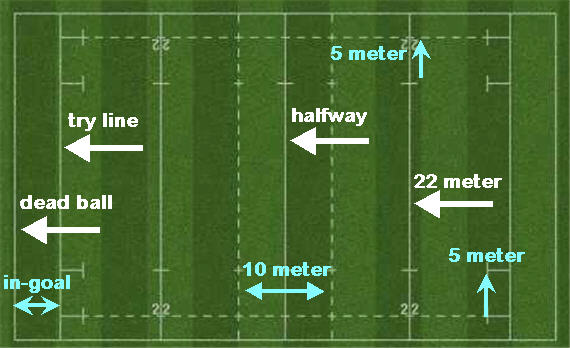Scrums happen in rugby for many different infringements by players. Dropping the ball is probably the most frequent but there are lots of other ways that a team can give away a scrum.
Sometimes, scrums are awarded when there is no fault on either side.
This article explains the eleven scenarios in which you get a scrum in a rugby match.
Knock-Ons From Dropping Passes
A knock-on occurs when a player fumbles the ball forward to the ground.

This is the classic source of scrums to the opposition.
You’ll often see the player reaching and dipping to regain the ball before it hits the ground. If he does so, then there is no offense.
There’s a fine line between juggling with the ball and actually throwing it forward and catching it (which is not allowed).
You can see some famous and comical examples in our article on whether you can pass the ball forward to yourself.
Knock-Ons From Dropping A High Ball
Do you groan when your scrum-half launches a box kick? It often isn’t the most exciting move in rugby.
But I bet you cheer when the opposition back fumbles the catch and spills the ball forward!
Outhalves will also target inexperienced wingers or fullbacks with what we call garryowens or bombs – long high kicks that can be devilish to catch as they drop down in a swirling wind.
The big advantage is a scrum to your team in an advanced position on the field.
Messing Up At The Lineout
We’ve already covered knock-ons, and they certainly result in scrums when forwards drop a ball in a lineout.
But that’s not the only way that mistakes in lineouts can result in a scrum.
There are rules that govern how the ball must be thrown in at the lineout.
Not straight

The referee will call “not straight!” if the ball doesn’t travel straight down the middle of the gap between the two lines of forwards.
This is to ensure there is a fair contest.
The team that isn’t throwing in the ball will get the scrum in this scenario.
Incorrect quick throws
You’ll sometimes see a back chase a long ball over the sideline and throw it in quickly before a normal lineout forms. The player can catch it himself or throw a longer pass to a teammate.
However, the quick throw has to be done correctly.
For example, if the ball travels forward or if it doesn’t travel five meters, then a scrum is awarded to the opposition.
Teams Can Choose To Scrum For Any Penalty Or Free Kick
When teams are awarded a penalty, they usually choose either to kick at goal or to kick it into touch for the line out.
However, the captain also has the option to take a scrum for an opposition infringement.
This is far less common with penalties than with free kicks.
The reason is that if a free kick is kicked out of play, the offending team gets the lineout. That is unlike with penalties. You can check out our article on the rules of when lineouts occur in rugby.
Unplayable Ball At Rucks And Mauls
Occasionally, a ruck or maul results in the ball being trapped under a pile of bodies.
If the referee decides that there was fault involved (e.g. the maul was dragged down), then a penalty is awarded. But sometimes, neither team is at fault.
You’ll see the scrumhalf desperately trying to fish out the ball until the referee decides that it’s not coming out.

“Ball is unplayable” is the referee’s call.
The referee will award the scrum to the team going forward – or if both teams were stationary, to the attacking team.
Note for older readers: the defending team used to get possession, which made for very defensive rugby.
The number of times that a ball is unplayable in a match has greatly reduced since 1990. There has been a corresponding reduction of scrums, as you can see in our graph.
If you want to understand more about how this reduction happened, check out our article on the average number of scrums in rugby.
Messing Up The Kick-Off Or Restart
This is probably the most embarrassing mistake that a flyhalf can make.
Check out our article on kick-offs and restarts in rugby if you need a bit of background to when these happen.
I’ll simply mention here that the kicker must ensure that the ball travels past ten meters. Otherwise, the opposition is awarded a scrum on the halfway line.
You may think that this should be a very simple task. But to be fair to the kicker, sometimes they are tasked with kicking high and short so that their forwards have a chance at regaining the ball.
The other problem is when the kicker sends the ball straight over the sideline with nobody touching it. Again, a scrum is awarded to the opposition on the halfway line.
Five-Second Rule At The The Ruck, Maul, Or Scrum
In my opinion, the “five-second” infringement isn’t given nearly as often as it should be.

When the team in possession has control of the ball at the back of a ruck, maul, or scrum – they are supposed to move it away within five seconds.
You’ll hear the referee shouting “use it!” at the scrumhalf as he stands over the ball at the back of a ruck.
If there is a delay, the referee warns the scrumhalf that the time is up.
And then, the rest of us watch the scrumhalf dawdling for another five seconds before doing anything.
Occasionally, the referee will penalize a lengthy delay at rucks. But they are more likely to yell “use it” a few more times.
My recommendation to World Rugby is to introduce a cattle-prod!
An Injury Forces The Referee To Stop Play
In rugby, the game usually continues when a player is injured and lying on the ground.
There are several exceptions.
Head injuries
If referees think that a serious head injury has occurred, they will stop play for immediate medical assistance.
Other players sometimes call this to the referee’s attention. In professional matches, a medical observer can instruct referees through their ear-piece to stop play.
In this scenario, the team in possession is awarded a scrum after the injured player has been attended to.
Injured players are interfering with play
We don’t mean here that the injured player is deliberately interfering.
What happens is that the physios run onto the field to attend to a player on the deck. That isn’t a problem if the play continues away from that area.
But if a bunch of burly forwards are following the ball towards the injured player, then more injuries can occur if they collide with the medics or prone player.
The referee will stop play and restart it with a scrum to the team in possession.
Player Takes The Ball Over Their Own Goal Line
Sometimes you’ll see a player being tackled as they try to run the ball away from their goal line.
If the tacklers can bundle the player into the in-goal area, their team is awarded a scrum on the five-meter line.
If you’re not sure about these positions on the pitch, we’ve marked the in-goal area at the bottom left of this diagram:

Another scenario is when a kick is blocked and rebounds backward over the team’s goal line. Then it’s a race to touch it down and “ground” the ball.
If the opposition gets there first, they get at try. If a player grounds the ball over their own line, then it’s a scrum to the opposition.
Ball Hits The Referee
When a ball cannons into a referee, this often gets the biggest cheer from the stands.
Likewise, if the referee trips over or bumps into a player during open play.
A scrum isn’t always awarded – it depends on whether the team in possession is put at a disadvantage by the contact.
Penalty Or Free Kick Is Too Slow
Kickers have one minute to take a penalty or a free kick.
If you follow international rugby, you may be wondering why Ireland flyhalf Johnny Sexton isn’t constantly penalized. As an Irish supporter, I’m grateful to him for being able to go make a cup of tea as he’s preparing to kick.
To be fair, he has never been penalized for going over time!
In thirty years of following rugby, I’ve only seen the referee whistle for this offense a handful of times.
And I’ve never seen it happen for a free kick.
Official List Of Rules

Here is a link to the official list of rules.
I think the layout is quite confusing, as many of the “separate” infringements are very similar.
This is why I’ve grouped the infringements into a smaller number of categories in this article.